


xxxxxRobert Louis Stevenson, the Scottish novelist, essayist, travel writer and poet, gained instant fame with his Treasure Island, an exciting tale of piracy and buried gold, published in 1883. He wrote over 40 adventure stories, including Kidnapped, Black Arrow, The Master of Ballantrae, and his horror story The Strange Case of Dr Jekyll and Mr Hyde. Suffering from a chest infection from an early age, Stevenson travelled constantly in search of a healthier climate, first in England and then on the Continent and the United States, before setting up home on one of the Samoan Islands in the South Pacific in 1889. During his journeys abroad he wrote a wealth of entertaining travel books, including An Inland Voyage, Travels with a Donkey, Across the Plains and In the South Seas. Many of his best short stories were published in The New Arabian Nights, and he produced some delightful poetry in his collections entitled A Child’s Garden of Verses and Underwoods. Today he is mostly remembered for his fast-moving tales of adventure, some historically based, written in a vigorous, graphic style, but he was also the master of the short story, showed skill as a journalist in his essays and critical works, and excelled as a travel writer. When he died in 1894, Tusitala (the Teller of Tales) was buried at the top of Mount Vaea, a height which overlooked his Samoan home and the sea.
ROBERT LOUIS STEVENSON 1850 - 1894
(Va, Vb, Vc)
Acknowledgements
Stevenson: detail, by the English portrait painter William Blake Richmond (1842-1921), 1887 – National Portrait Gallery, London. Vailima: by the Italian painter Girolamo Nerli (c1860-1926), 1892. Barrie: by the Irish studio photographer George Charles Beresford (1864-1938), 1902 – National Portrait Gallery, London. Henley: by the Irish studio photographer George Charles Beresford (1864-1938), 1903 – National Portrait Gallery, London. Haggard: by the Irish studio photographer George Charles Beresford (1864-1938), 1902 – National Portrait Gallery, London. Hope: by the Irish studio photographer George Charles Beresford (1864-1938), 1903 – National Portrait Gallery, London. Quiller-Couch: cigarette card, after the English photographer Walter Benington, 1937 – National Portrait Gallery, London.
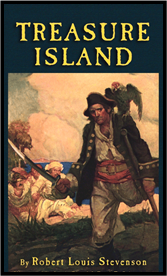
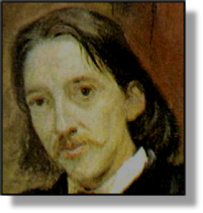 xxxxxRobert Louis Stevenson, the Scottish novelist, essayist, travel writer and poet, is known the world over for his Treasure Island, an exciting tale of piracy and buried gold, published in 1883. Among his other works were his adventure stories Kidnapped, Black Arrow and The Master of Ballantrae, and his psychological thriller The Strange Case of Dr Jekyll and Mr Hyde. As a poet he is remembered for his Child’s Garden of Verses, a nostalgic recollection of the emotions and sensations of his childhood, published in 1885, and his later collections of verse under the titles Underwoods and Ballads,
xxxxxRobert Louis Stevenson, the Scottish novelist, essayist, travel writer and poet, is known the world over for his Treasure Island, an exciting tale of piracy and buried gold, published in 1883. Among his other works were his adventure stories Kidnapped, Black Arrow and The Master of Ballantrae, and his psychological thriller The Strange Case of Dr Jekyll and Mr Hyde. As a poet he is remembered for his Child’s Garden of Verses, a nostalgic recollection of the emotions and sensations of his childhood, published in 1885, and his later collections of verse under the titles Underwoods and Ballads,
xxxxxStevenson was born in Edinburgh, the son of a prosperous civil engineer. His schooling was often interrupted by illness - a chest infection which plagued him for the rest of his life - but he attended Edinburgh university from the age of 17 and, after a short period studying engineering, chose to work for a law degree. In this he had the support of his parents, but during his years as a student the young Stevenson rebelled against his strict, bourgeois upbringing, declared himself an agnostic, and led a bohemian existence. He qualified as a lawyer in 1875, but by then he had written a number of essays for various magazines and, encouraged by their favourable reception, had decided to make writing his career.
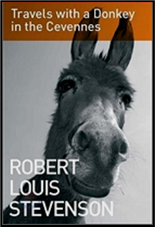
xxxxxOn account of his frail health he was obliged to spend much of his time in search of a warmer climate. As a result his early works were travel books by necessity, but made into attractive narratives of merit by Stevenson’s engaging and picturesque style. These journeys on the continent inspired, amongst others, An Inland Voyage of 1878 - based on a canoe trip through Belgium and France two years earlier - and Travels with a Donkey, a delightful and amusing account of a hike through the mountainous terrain of the Cévennes in southern France with a stubborn donkey called Modestine.
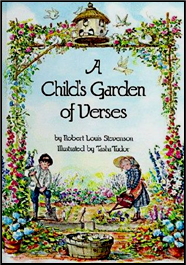 xxxxxIt was during one of these visits to France that he met his wife-to-be, Fanny Osbourne, an American with two children who was estranged from her husband. When she returned to her home in California in 1878 he decided to join her. Despite having little money and seriously weak from his illness, he set out the following year and, after an arduous journey across the Atlantic and the United States - during which he came close to death and described himself as “a mere complication of cough and bones” - he reached San Francisco and met up with Fanny. By then she had divorced her husband. She nursed Stevenson back to good health, and they were married in May 1880. They returned to England the same year. As it so happened, this demanding and near fatal journey not only had a happy ending, but also provided him with the material for three books, Across the Plains (1892), The Amateur Emigrant (1895), and The Silverado Squatters (1883), a work based on an abandoned silver mine on Mount Saint Helena where they spent their honeymoon.
xxxxxIt was during one of these visits to France that he met his wife-to-be, Fanny Osbourne, an American with two children who was estranged from her husband. When she returned to her home in California in 1878 he decided to join her. Despite having little money and seriously weak from his illness, he set out the following year and, after an arduous journey across the Atlantic and the United States - during which he came close to death and described himself as “a mere complication of cough and bones” - he reached San Francisco and met up with Fanny. By then she had divorced her husband. She nursed Stevenson back to good health, and they were married in May 1880. They returned to England the same year. As it so happened, this demanding and near fatal journey not only had a happy ending, but also provided him with the material for three books, Across the Plains (1892), The Amateur Emigrant (1895), and The Silverado Squatters (1883), a work based on an abandoned silver mine on Mount Saint Helena where they spent their honeymoon.
xxxxxHis marriage to Fanny marked the beginning of the most productive period of his career. Over the next ten years especially, during which they made frequent trips to the continent and one to the United States, he produced a stream of short stories, essays, romances and poems. These included his volume of short stories entitled The New Arabian Nights, his essays Virginibus Puerisque and Familiar Studies of Men and Books; two of his best short stories, The Merry Men and Thrawn Janet; two volumes of verse, A Child’s Garden of Verses and Underwoods, and a number of his major works: his famous adventure tale Treasure Island (begun in serial form with the title The Sea Cook), the historical novels Black Arrow, Kidnapped, and The Master of Ballantrae, and the horror story The Strange Case of Dr Jekyll and Mr Hyde, a work which greatly widened the scope of his public appeal. And many of his works, like the last mentioned, had subtle moral overtones, upholding good against evil and right against wrong.
Vc-1881-1901-Vc-1881-1901-Vc-1881-1901-Vc-1881-1901-Vc-1881-1901-Vc-1881-1901-Vc
xxxxxOne of Stevenson’s closest friends, William Henley (1849-1903), was a poet, critic and editor. At the age of 25 he lost part of his left leg due to illness and Stevenson used him as a model for his peg-leg villain Long John Silver. Henley edited a number of periodicals, notably the Scots Observer, and through these journals he encouraged the young writers of the day, publishing works by Thomas Hardy, Rudyard Kipling, George Bernard Shaw, H.G. Wells, James Barrie, and Stevenson himself. His finest verse - free and somewhat unconventional - is to be found in his two collections, London Voluntaries of 1893 and In Hospital of 1903, but he is best known today for his poem Invictus of 1875 with its closing lines: “I am the master of fate, I am the captain of my soul.”
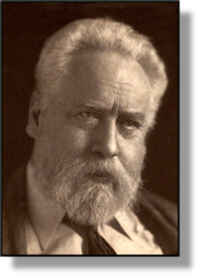 xxxxxOne of Stevenson’s closest friends was the poet, critic and editor William Henley (1849-1903). Like Stevenson he had to fight against illness for much of his life. Diagnosed with osteomyelitis at the age of 12, he had to have his left leg amputated below the knee when he was 25. A few years later he would certainly have lost part of his right leg had it not been for the skill of the pioneer surgeon Joseph Lister. Stevenson first met Henley at Edinburgh infirmary in 1874, when he was recovering from his operation, and they became firm friends. At one time they worked together producing Deacon Brodie and other plays. A big built man with a
xxxxxOne of Stevenson’s closest friends was the poet, critic and editor William Henley (1849-1903). Like Stevenson he had to fight against illness for much of his life. Diagnosed with osteomyelitis at the age of 12, he had to have his left leg amputated below the knee when he was 25. A few years later he would certainly have lost part of his right leg had it not been for the skill of the pioneer surgeon Joseph Lister. Stevenson first met Henley at Edinburgh infirmary in 1874, when he was recovering from his operation, and they became firm friends. At one time they worked together producing Deacon Brodie and other plays. A big built man with a 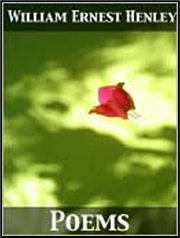 fiery zest for life - despite his disability - Stevenson later admitted that he had modelled his character Long John Silver, the peg-leg villain, upon him.
fiery zest for life - despite his disability - Stevenson later admitted that he had modelled his character Long John Silver, the peg-leg villain, upon him.
xxxxxHenley was born in Gloucester and attended Crypt Grammar School in the town. It was while in the infirmary - a stay of some twenty months - that he began writing verse about his time in hospital. Once recovered he began a career in publishing. He went to London in 1877 to edit the magazine London, and then edited the Magazine of Art before being appointed editor of the Scots Observer in 1889. In this and his earlier periodicals he encouraged the young writers of the day, publishing works by Thomas Hardy, Rudyard Kipling, George Bernard Shaw, H.G. Wells, James Barrie, and Stevenson himself. He was also a close friend of the French sculptor Auguste Rodin, and much admired his works.
xxxxxAs a poet his finest work is to be found in his two collections, London Voluntaries of 1893 and In Hospital of 1903. His verse was somewhat unconventional, being free and impressionistic in style, but today he is chiefly remembered for his poem Invictus (Invincible) published in 1875. A powerful, defiant poem, the last eight lines read:
Beyond this place of wrath and tears
Looms but the horror of the shade,
And yet the menace of the years
Find, and shall find me, unafraid.
It matters not how straight the gate,
How charged with punishments the scroll,
I am the master of my fate;
I am the captain of my soul.
xxxxxThe friendship between Stevenson and Henley came to an abrupt end in 1888 when Henley accused Fanny (Stevenson’s wife) of plagiarism. Following the break-up Henley became very bitter and was widely criticised when, after the death of Stevenson, he wrote a highly critical article about his one-time friend.
xxxxxIncidentally, Henley’s little daughter Margaret particularly liked James Barrie and regarded him as her friend. When he came to call, she would greet him with “Fwendy fwendy”. Later Barrie used the name Wendy in his play and novel Peter and Wendy, and it became very popular.
Including:
William Henley,
Rider Haggard,
Anthony Hope and
Arthur Quiller-Couch

xxxxxBut whilst the 1880s were happy and productive years - made the more successful by Fanny’s constant support - he endured several bouts of sickness, including lung haemorrhages, and it was with this in mind that they decided to seek warmer climes. He and his family (including his mother and his stepson Lloyd) made several chartered cruises to the South Pacific (later described in his A Footnot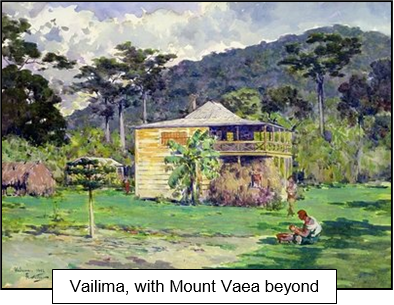 e to History and In the South Seas), calling and sometimes staying at various islands like Tahiti and Honolulu, before deciding to settle on one of the Samoan Islands (now called Western Samoa). Here in 1889 they built an attractive house on a 400 acre site at Vailima, just south of the port of Apia, and quickly entered into the life of the community. The climate suited him and when he died there in December 1894, aged 44, it was from a stroke, not the chest infection - possibly tuberculosis - which had plagued him all his life. He left incomplete his last novel Weir of Hermiston, a work which, by the quality of its dialogue and the maturity of its style, was hailed as a masterpiece in the making by many critics.
e to History and In the South Seas), calling and sometimes staying at various islands like Tahiti and Honolulu, before deciding to settle on one of the Samoan Islands (now called Western Samoa). Here in 1889 they built an attractive house on a 400 acre site at Vailima, just south of the port of Apia, and quickly entered into the life of the community. The climate suited him and when he died there in December 1894, aged 44, it was from a stroke, not the chest infection - possibly tuberculosis - which had plagued him all his life. He left incomplete his last novel Weir of Hermiston, a work which, by the quality of its dialogue and the maturity of its style, was hailed as a masterpiece in the making by many critics.
xxxxxDuring his short stay at Vailima Stevenson became loved and respected by the local community. They called him Tusitala - the Teller of Tales . When he died they carried his body to the top of Mount Vaea - a height overlooking his Samoan home - and buried him at a spot overlooking the sea. His tomb is inscribed with the words of his poem:
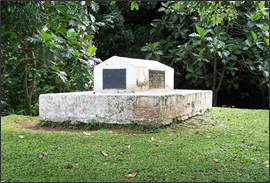 Under the wide and starry sky,
Under the wide and starry sky,
Dig the grave and let me die.
Glad did I live and gladly die,
And I laid me down with a will.
This be the verse you grave for me,
Here he lies where he longed to be;
Home is the sailor, home from the sea,
And the hunter home from the hill.
xxxxxStevenson was a skilful story teller and character maker with a vigorous, graphic style. This, together with his choice of fast moving adventures, romances and tales of fantasy, made him a popular writer not only with children but also with the public at large. Treasure Island, for example, had all the ingredients of a good, exciting yarn with its pirates, buried gold and unforgettable characters like Pew and the one-legged Long John Silver, whilst tales like Kidnapped and Black Arrow highlighted the drama and romance within an historical setting. On the other hand his tales of the supernatural and his fascinating story woven around the split personality of Dr Jekyll and Mr Hyde played upon the fear of the unknown and the unpredictable.
xxxxxBut Stevenson’s talent went far beyond that of a fiction writer of schoolboy adventure and horror stories. He succeeded in a variety of genres. He was a master of the short story, showed original skill as a journalist in his essays and works of criticism, and excelled as a travel writer. His writings on the South Seas, for example, capture - as few had done before or since - the atmosphere, the colour and the people of this exotic region. And his Child's Garden of Verses, dedicated to his childhood nurse “Cummy”, though naive in word and format, still ranks as one of the finest collections of children’s p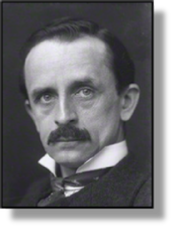 oetry in the English language.
oetry in the English language.
xxxxxAmong those who admired his work and were influenced by it were the writers Rudyard Kipling, Joseph Conrad, G.K. Chesterton and John Buchan, author of Prester John and the well-known tale of espionage The Thirty Nine Steps. Whilexliving at Bournemouth in the mid-1880s he met the American-born author Henry James, and he carried on a long correspondence with his fellow countryman Sir James Barrie (1860-1937) (illustrated), creator of the fairy-tale play Peter Pan, produced in 1904.
xxxxxIncidentally, Stevenson confided that much of his inspiration came from “the little people” he met in his dreams. He also admitted that his horror tale The Strange Case of Dr Jekyll and Mr Hyde was inspired by a nightmare. He wrote the story in three days, but then, having doubts about it, threw the manuscript in the fire. He then had second thoughts, re-wrote it in another three days, and sent it for publication! ……
xxxxx……xWhile living at Vailima in Samoa he became friendly with the American Land Commissioner Henry Clay Ide. His little daughter complained that because her birthday fell on Christmas Day she only received one set of presents. By a deed of gift in his will, Stevenson left her his own birthday - the 13th November! ……
xxxxx……xStevenson wrote three novels in collaboration with his step-son Lloyd Osbourne: the black comedy The Wrong Box (1889), the mystery The Wrecker (1892), and The Ebb Tide (1894), a tale of exploitation in the South Seas. ……
Xxxxx……xStevenson’s grandfather, Robert Stevenson, was an engineer. From 1807 to 1812 he assisted the Scottish engineer John Rennie in the building of the Bell Rock Lighthouse on the east coast of Scotland.
xxxxxRider Haggard (1856-1925) was another English writer at this time who gained overnight fame with an exciting adventure story. Having read Stevenson’s Treasure Island he came up with King Solomon’s Mines, a tale about a group of intrepid treasure hunters and their travels in the lost land of Kukuanas. He followed this up with three other works based on his life in South Africa: She, Jess and Allan Quartermain, all published in 1887. In all he wrote some 40 novels set in colourful locations in lost, strange lands across the world, some based on his knowledge of Zulu culture, others taking their themes from ancient Egypt. In many of his mystic romances women played the leading role. He was also deeply interested in agricultural reform and rural matters in general. His two works, A Farmer’s Year and Rural England made an important contribution to these subjects. He was a life-long friend of the British story teller and poet Rudyard Kipling.
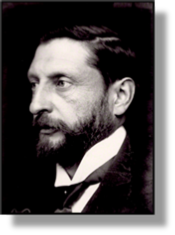 xxxxxAnother English writer at this time who gained a name for his colourful tales of adventure - set in lost lands and filled with strange characters - was Rider Haggard (1856-1925). After reading Stevenson’s Treasure Island, he purposefully set out to produce a popular work of that kind, and succeeded with his famous romantic tale King Solomon’s Mines, written in six weeks and published in 1885.
xxxxxAnother English writer at this time who gained a name for his colourful tales of adventure - set in lost lands and filled with strange characters - was Rider Haggard (1856-1925). After reading Stevenson’s Treasure Island, he purposefully set out to produce a popular work of that kind, and succeeded with his famous romantic tale King Solomon’s Mines, written in six weeks and published in 1885.
xxxxxHaggard was born at Bradenham Hall, Norfolk. He attended Ipswich grammar school, and at the age of 19 went out to South Africa to serve in the colonial service in Natal and the Transvaal. On returning to England in 1879, he settled on the family estate in Norfolk and became a barrister. However, he never practised law, but divided his time between writing a string of adventure novels - over 40 in number - and producing valuable works on agricultural matters and social conditions throughout England.
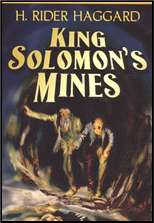
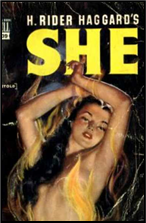 xxxxxKing Solomon’s Mines, centred around an intrepid group of treasure hunters and their hazardous adventures in the lost land of Kukuanas, was an overnight success. He quickly followed this up with three other exciting, action-filled tales based on his experience in South Africa: She, Jess and Allan Quartermain, all published in 1887. Many more followed, one to three a year, all set in colourful locations in lost, strange lands from as far afield as Iceland, Mexico and Egypt. He was particularly fascinated with Zulu culture and the prowess of their warriors, as is to be seen in his trilogy Marie, Child of the Storm and Finished (1912-17), and Cleopatra, published in 1889, was the first of several novels on ancient Egypt. And in many of his mystic romances women played the major roles.
xxxxxKing Solomon’s Mines, centred around an intrepid group of treasure hunters and their hazardous adventures in the lost land of Kukuanas, was an overnight success. He quickly followed this up with three other exciting, action-filled tales based on his experience in South Africa: She, Jess and Allan Quartermain, all published in 1887. Many more followed, one to three a year, all set in colourful locations in lost, strange lands from as far afield as Iceland, Mexico and Egypt. He was particularly fascinated with Zulu culture and the prowess of their warriors, as is to be seen in his trilogy Marie, Child of the Storm and Finished (1912-17), and Cleopatra, published in 1889, was the first of several novels on ancient Egypt. And in many of his mystic romances women played the major roles.
xxxxxIn addition to writing popular fiction, Haggard was also deeply interested in agricultural reform and rural matters in general. His most important works in this regard were A Farmer’s Year and Rural England, based on extensive travelling throughout the country. A one time he was also commissioned to report on land settlement in the United States.
xxxxxIncidentally, Haggardxwrote the fantasy novel World’s Desire, published in 1890, with the Scots writer Andrew Lang. A collector of folk and fairy tales, Lang is remembered to day for his series of twelve Fairy Books, published from 1889 to 1910. ……
xxxxx…… Like his life-long friend Rudyard Kipling, Haggard was a great believer in the British Empire, though his novels did show some concern about the encroachment of European ways upon the indigenous population in Africa. ……
xxxxx…… It is said that the idea for the subject matter of his most famous work King Solomon’s Mines came from the discovery of the ruins of the Great Zimbabwe Empire in 1867, an empire which flourished in south-east Africa from 1200 to 1500. ……
xxxxxAnother teller of adventure stories at this time and, like Haggard, a barrister by profession, was the Englishman Anthony Hope (1863-1933). He wrote some twenty novels, and a number of plays and short stories, but he is remembered today for just two of his tales of political intrigue, The Prisoner of Zenda - which was an overnight success in 1894 - and its sequel Rupert of Hentzau, published in 1898, both exciting yarns set in the imaginary Balkan kingdom of Ruritania.
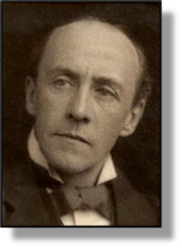
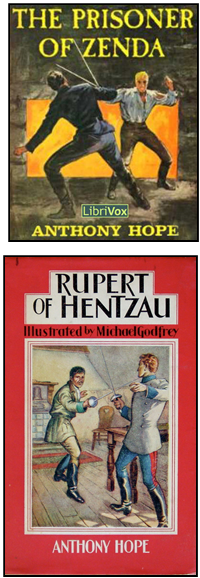 xxxxxAnother barrister-cum-swashbuckling-story-teller at this time was the Englishman Anthony Hope (1863-1933), pen name of Sir Anthony Hope Hawkins. Hope was born in London and educated at Marlborough College and Oxford University. He became a barrister in 1887, but in 1894 he gained instant fame with his highly successful The Prisoner of Zenda, an exciting story of political intrigue set in the imaginary Balkan kingdom of Ruritania. He then gave all his time over to writing.
xxxxxAnother barrister-cum-swashbuckling-story-teller at this time was the Englishman Anthony Hope (1863-1933), pen name of Sir Anthony Hope Hawkins. Hope was born in London and educated at Marlborough College and Oxford University. He became a barrister in 1887, but in 1894 he gained instant fame with his highly successful The Prisoner of Zenda, an exciting story of political intrigue set in the imaginary Balkan kingdom of Ruritania. He then gave all his time over to writing.
xxxxxDuring his career he wrote over thirty novels, and these included the social comedy The Dolly Dialogues, The God in the Car, based on the career of the empire-builder Cecil Rhodes, Phroso, a romantic adventure set on a Greek island, Simon Dale, an historical novel involving the actress Nell Gwyn, and the Ruritanian romance The King’s Mirror. He also wrote short stories and produced a number of plays - notably The Adventure of Lady Ursula - but none of these works approached the immense popularity gained by The Prisoner of Zenda and, to a lesser extent, its sequel Rupert of Hentzau, published in 1898.
xxxxxHe went on a three-month publicity tour of the United States in 1897 and received a warm reception. He was knighted in 1918 for his service in the Ministry of Information during the First World War, and he spent the last sixteen years of his life in retirement. His mother, Jane Isabella Grahame, was an aunt of Kenneth Grahame, the author of the children’s classic The Wind in the Willows.
xxxxxAnd worthy of mention here is the Cornish writer and critic Arthur Quiller-Couch (1863-1944). His adventure story Dead Man’s Rock was very much in the vein of Treasure Island, and he completed Stevenson’s unfinished novel St. Ives, a tale of adventure about a French prisoner of war during the Napoleonic Wars. Today, Q - as he was known - is chiefly remembered for his literary criticism and his Oxford Book of English Verse, produced in 1900.
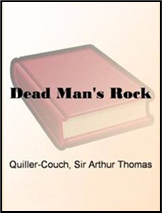
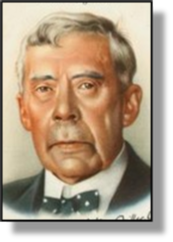 xxxxxAnd well worthy of mention here is the Cornish writer and critic Arthur Quiller-Couch (1863-1944). He attended Trinity College, Oxford, and it was while there that he published, in 1887, Dead Man’s Rock, an adventure romance very much in the vein of Treasure Island. He followed this up with Troy Town and The Splendid Spur. In 1898 he completed Stevenson’s unfinished novel St. Ives, a story telling of the adventures of a French prisoner of war in England during the Napoleonic Wars.
xxxxxAnd well worthy of mention here is the Cornish writer and critic Arthur Quiller-Couch (1863-1944). He attended Trinity College, Oxford, and it was while there that he published, in 1887, Dead Man’s Rock, an adventure romance very much in the vein of Treasure Island. He followed this up with Troy Town and The Splendid Spur. In 1898 he completed Stevenson’s unfinished novel St. Ives, a story telling of the adventures of a French prisoner of war in England during the Napoleonic Wars.
xxxxxToday, Quiller-Courch - who published under the pen name of Q - is chiefly remembered for his literary criticism and his monumental Oxford Book of English Verse 1250-1900, produced in 1900. His own poetical works are contained in his Poems and Ballads of 1896. His other novels included The Ship of Stars of 1899 and The Adventures of Harry Revel and The Shining Ferry, published in the opening years of the 20th century. He was knighted in 1910.

xxxxxIncidentally, his popular story entitled The Roll-Call of the Reef was based on the loss of HMS Primrose during a snowstorm in January 1809. The cruiser ran aground upon the Manacles, a treacherous set of rocks a mile off Lizard Point in Cornwall, and all the crew were lost save a young drummer boy. And on the same night another vessel, the troop ship Dispatch, returning home from the Battle of Corunna, was also wrecked on the Manacles. The 7th Hussars lost 104 men, and only seven men were saved.








 xxxxxRobert Louis Stevenson, the Scottish novelist, essayist, travel writer and poet, is known the world over for his Treasure Island, an exciting tale of piracy and buried gold, published in 1883. Among his other works were his adventure stories Kidnapped, Black Arrow and The Master of Ballantrae, and his psychological thriller The Strange Case of Dr Jekyll and Mr Hyde. As a poet he is remembered for his Child’s Garden of Verses, a nostalgic recollection of the emotions and sensations of his childhood, published in 1885, and his later collections of verse under the titles Underwoods and Ballads,
xxxxxRobert Louis Stevenson, the Scottish novelist, essayist, travel writer and poet, is known the world over for his Treasure Island, an exciting tale of piracy and buried gold, published in 1883. Among his other works were his adventure stories Kidnapped, Black Arrow and The Master of Ballantrae, and his psychological thriller The Strange Case of Dr Jekyll and Mr Hyde. As a poet he is remembered for his Child’s Garden of Verses, a nostalgic recollection of the emotions and sensations of his childhood, published in 1885, and his later collections of verse under the titles Underwoods and Ballads, 
 xxxxxIt was during one of these visits to France that he met his wife-
xxxxxIt was during one of these visits to France that he met his wife- xxxxxOne of Stevenson’s closest friends was the poet, critic and editor William Henley (1849-
xxxxxOne of Stevenson’s closest friends was the poet, critic and editor William Henley (1849- fiery zest for life -
fiery zest for life -
 e to History and In the South Seas), calling and sometimes staying at various islands like Tahiti and Honolulu, before deciding to settle on one of the Samoan Islands (now called Western Samoa). Here in 1889 they built an attractive house on a 400 acre site at Vailima, just south of the port of Apia, and quickly entered into the life of the community. The climate suited him and when he died there in December 1894, aged 44, it was from a stroke, not the chest infection -
e to History and In the South Seas), calling and sometimes staying at various islands like Tahiti and Honolulu, before deciding to settle on one of the Samoan Islands (now called Western Samoa). Here in 1889 they built an attractive house on a 400 acre site at Vailima, just south of the port of Apia, and quickly entered into the life of the community. The climate suited him and when he died there in December 1894, aged 44, it was from a stroke, not the chest infection - Under the wide and starry sky,
Under the wide and starry sky, oetry in the English language.
oetry in the English language.  xxxxxAnother English writer at this time who gained a name for his colourful tales of adventure -
xxxxxAnother English writer at this time who gained a name for his colourful tales of adventure -
 xxxxxKing Solomon’s Mines, centred around an intrepid group of treasure hunters and their hazardous adventures in the lost land of Kukuanas, was an overnight success. He quickly followed this up with three other exciting, action-
xxxxxKing Solomon’s Mines, centred around an intrepid group of treasure hunters and their hazardous adventures in the lost land of Kukuanas, was an overnight success. He quickly followed this up with three other exciting, action-
 xxxxxAnother barrister-
xxxxxAnother barrister-
 xxxxxAnd well worthy of mention here is the Cornish writer and critic Arthur Quiller-
xxxxxAnd well worthy of mention here is the Cornish writer and critic Arthur Quiller-



